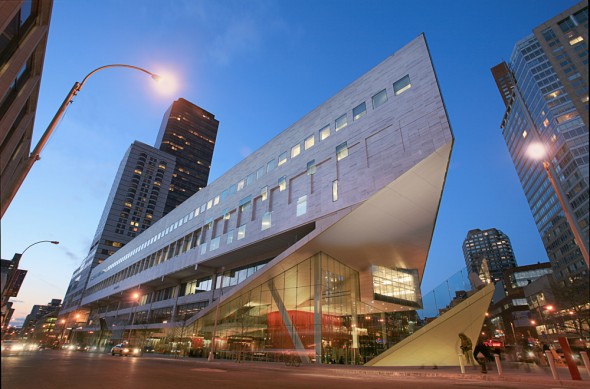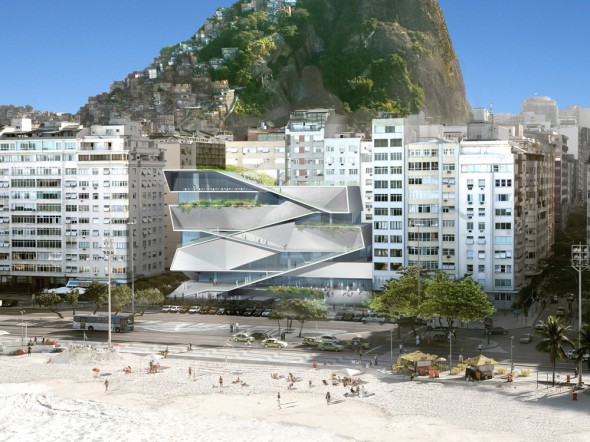
A Conversation with Architect Charles Renfro
Charles Renfro was named the third addition to duo Elizabeth Diller and Ricardo Scofidio’s eponymous firm in 2004. Renfro joined a partnership already famous for constructing a pavilion out of fog in Yverdon-les-Bains, Switzerland and receiving a MacArthur Fellowship for their discipline-agnostic installations, art and architecture. Renfro has added his mark to several recent New York City landmarks through his collaboration with the partners at DS+R. Two recently inaugurated examples include the High Line park and Lincoln Center’s Alice Tully Hall.
What are you working on today?
We seem to constantly be on airplanes these days, flying between the Middle East, South America, Asia and North America. I’m not sure it’s a sign of our ascendancy or of a bad economy. There is virtually no commercial work being made in the States, so all of our work here is institutional: University projects and studies for future cultural work. Our plum new job is the new Museum of Image and Sound in Rio de Janeiro, right on Copacabana Beach. It’s a perfect program on a perfect site.
What’s your dynamic like with your partners?
We all work on everything, which can be a little exhausting at times. Most other offices split the workload between the partners. We work as collaborators—we are greater than the sum of our parts. We get excited by the same things and we share a similar level of anxiety, which can also be exhausting. Of course, ideas don’t simply drop from the sky. But by the time they get airplay, they have been so touched by one of the other partners or the staff that they are virtually unrecognizable.
Why did you become an architect?
I have a great ability to visualize three-dimensional space. I was drawing houses and airports from the time I was eight years old. I made a model of an invented town when I was in kindergarten. My mom will probably correct me when she reads this, but I used to think that what I wanted to do was called ‘real estate,’ so I had little rubber stamps made reading ‘Renfro Real Estate.’ How is it that an eight-year-old would understand the concept of real estate before architecture?
What do you find to be the most rewarding aspect of your work? What is it that you could do without?
Designing and drawing are still the loves of my life. Number crunching and contracts are not. Unfortunately, as you become more successful, there is more and more of the latter. You have to wedge in the former. I devote 110 percent of my time to what most people would call work. I call it life. Some people would be horrified that there is so little separation between ‘living’ and ‘working’ in my life. I think it’s exhilarating. Then you know you are doing something real.
What is the next great New York City landmark? Or what should be?
New York, as exciting and progressive as it is, has not seen the completion of an architectural masterwork since the Guggenheim. Many people might object to this assessment, including my partners, but I believe we are due for a great new building that is not tied to commercial endeavors. Perhaps this time of reflection will engender such a project.

You are from Texas, a place that is, in many ways, a great counterpoint to New York. Does that identity influence your work?
I was very influenced by the dynamism of Houston in the ’70s. The city was growing so fast they erected new buildings around billboards. It was breathtaking, even if there was no collective consciousness about what it added up to. Texas is a place where imagination and determination can make things happen. I try to bring a similar enthusiasm to our practice in New York.
Do you think the media and architects are doing a good job of talking about architecture with the general public?
There are only four full time architecture writers employed at American newspapers. This is a shame given the fact that we spend most of our time inside buildings. So the problem is twofold: there is little architectural discourse within the public realm and, more disturbingly, there is a lack of awareness and education about architecture in our school system. Architecture, particularly public architecture, is a social act, and a collective act. Americans opt for the individual over the collective, thus we are more interested in celebrities and becoming famous.
Diller and Scofidio have talked about working within other disciplines because of a recession and tough economic times for architecture in the ’80s. How do you see the current climate, coming out of a global recession?
Most of the cross-disciplinary and paper architecture provocateurs of the previous generations are now making major buildings around the world. There are plenty of economies that keep this set busy, despite the downturn in the economy. Younger people are benefiting and building too. The upshot is that most of the thinking in our academies and by younger practitioners is geared towards a building practice. There are a lot of problems in the profession that need to be addressed such as exploring alternative energy sources and making architecture more green. These matters will keep many of our most intelligent and ambitious thinkers focused on the building profession.
Any current obsessions?
I am obsessed with a band from London called Micachu & The Shapes. I have also just started reading a collection of essays by Allan Kaprow called, “The Blurring of Art and Life.” He was interested in artistic practice operating within daily life. As an architect, this notion appeals to me since buildings are also quotidian artifacts that have the ability to affect life. Great architecture is not rarefied and distant, but active, engaged and transformational.
– Joscelin Cooper

